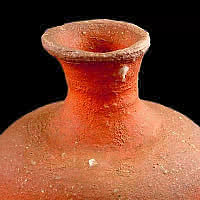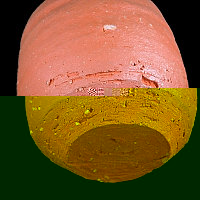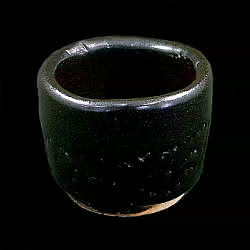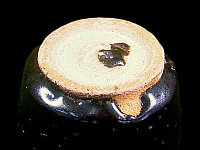|


Published by Yakimono.net June 2002
The Work of Artist Kato Kozo

(L) Hikidashi-guro (R) Yakishime Tokkuri
Everyone knows how space is such a premium in Japan. Around the world that fact is known as well, most of my friends back in the US ask if I live in a "rabbit hutch." Just for the record I do not -- I live in an old boro-boro house (falling apart house) that some say is actually quite wabi sabi.
For many potters, how to maximize space in a kiln in order to fire as many pieces as possible is a key concern. Mino potter Kato Kozo has addressed his own spacing concerns by adding a new style to his firing repertoire. In the back of his anagama (single-chamber kiln), Shino glaze doesn't melt as properly as Kato would like it to. In the past he's just filled the space with empty saggars but that all changed last autumn. After having tested various clays -- and finally settling on a Shigaraki clay -- Kato decided to add a few yakishime works into the back of the kiln (yakishime means high-fired unglazed stoneware).

Like Japan, space is at a premium in Kato's kiln and thus, such yakishime pieces are quite rare. Nevertheless, the works are not what we expect from Kato Kozo's kiln, which is just one more reason that this tokkuri is so pleasing. Not only for the almost alive shape that appears to be breathing, but also for incredibly wonderful tsuchi-aji (clay flavor) that also feels quite alive on this tokkuri. I'm sure you can imagine how wonderful the tsuchi-aji gets when cold sake is poured in it and how that will only deepen over time. Ah, I just love thinking about that as I turn the tokkuri round and round in my hands.
Kato has such a wonderful sensitivity to his materials, and his technique is more spirited than intellectual -- that's all quite visible on this unglazed form. I love the stone bursts around the middle and also the one right below the lip. The lip is full of character and is just asking to be poured; it's perfect. The shoulders have slight rises and bumps that also give the tokkuri its charming personality.
 
Sometimes the summer nights get so quiet, especially after nine or so. No breezes are moving and the summer insects have all gone silent. It's a good time for quiet reflection on each day and also about how the days strung together like pearls on a necklace, make up a life. Summer silence is golden.
When drinking sake with such inward meditations in my "no-mind" it's best to use a dark guinomi to aid in the inner silence. Again, Kato Kozo comes through with his Zen-spirited vessels. This quite regularly shaped hikidashi-guro (meaning "pulled out black from the kiln") has a thickly applied glaze and a very rounded drinking lip. The kodai (foot) is wide and strong and the clay has already begun to change to a yellow hue after only a few uses.


Summer nights and Kato Kozo's works -- both deep, quiet spirits with more than enough space for us all.
LEARN MORE
Kato Kozo - King of Mino
Kato Kozo - Resurrecting 16th Century Kiln Techniques
WHAT IS MINO? Learn more in our Pottery Guidebook
|